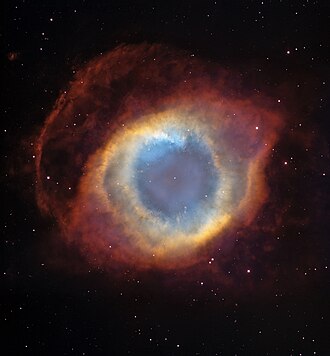Planetary nebula
(Redirected from Planetary Nebula)
Planetary Nebulae are a type of astronomical object that represent a phase in the life cycle of certain types of stars. These nebulae are characterized by their beautiful, often symmetric, glowing shells of ionized gas that are ejected from red giant stars in the later stages of their evolution. Despite their name, planetary nebulae have no direct association with planets. The term originated in the 18th century when astronomers using early telescopes observed these objects as round and planet-like in appearance, but we now know they are vastly different in nature.
Formation and Evolution
The life of a planetary nebula begins when a star of low to intermediate mass (approximately 0.8 to 8 times the mass of the Sun) exhausts the hydrogen in its core. The star then expands into a red giant, during which it starts to shed its outer layers into space over a period of thousands of years. This material, moving away from the star, forms a shell of gas and dust. As the star continues to evolve, it heats up, emitting ultraviolet radiation that ionizes the surrounding ejected material, causing it to glow brightly. The vivid colors observed in planetary nebulae, typically reds and greens, are due to the emission of light at specific wavelengths by different elements in the gas, such as hydrogen and oxygen.
The central star, now in its final stages, becomes a white dwarf, a dense, hot core that continues to illuminate the surrounding nebula for tens of thousands of years until both the nebula and the white dwarf fade away.
Observational History
The first planetary nebula discovered was the Dumbbell Nebula (M27) by Charles Messier in 1764. Since then, thousands of planetary nebulae have been identified within our Milky Way galaxy, and they have been observed in other galaxies as well. They play a crucial role in the chemical enrichment of the interstellar medium, returning material to space that will contribute to the formation of new stars and planets.
Notable Planetary Nebulae
- Ring Nebula (M57): One of the most famous planetary nebulae, located in the constellation Lyra, easily observable with small telescopes. - Helix Nebula (NGC 7293): Often referred to as the "Eye of God," it is one of the closest planetary nebulae to Earth, located in the constellation Aquarius. - Cat's Eye Nebula (NGC 6543): Known for its complex structures and multiple shells, indicating a series of ejection events by the central star.
Scientific Importance
Planetary nebulae are important to the study of stellar evolution. They provide insights into the processes that occur in the late stages of a star's life and the mechanisms behind the ejection of stellar material. Additionally, by studying the composition of planetary nebulae, astronomers can gain understanding of the chemical evolution of galaxies.
Challenges in Study
Studying planetary nebulae presents challenges, as their brightness and visibility decrease over time. Advanced telescopes and imaging techniques are required to observe the finer details of these distant objects. Furthermore, the exact mechanisms driving the shapes and structures of planetary nebulae, including the role of binary star systems, remain areas of active research.
Transform your life with W8MD's budget GLP-1 injections from $125.
W8MD offers a medical weight loss program to lose weight in Philadelphia. Our physician-supervised medical weight loss provides:
- Most insurances accepted or discounted self-pay rates. We will obtain insurance prior authorizations if needed.
- Generic GLP1 weight loss injections from $125 for the starting dose.
- Also offer prescription weight loss medications including Phentermine, Qsymia, Diethylpropion, Contrave etc.
NYC weight loss doctor appointments
Start your NYC weight loss journey today at our NYC medical weight loss and Philadelphia medical weight loss clinics.
- Call 718-946-5500 to lose weight in NYC or for medical weight loss in Philadelphia 215-676-2334.
- Tags:NYC medical weight loss, Philadelphia lose weight Zepbound NYC, Budget GLP1 weight loss injections, Wegovy Philadelphia, Wegovy NYC, Philadelphia medical weight loss, Brookly weight loss and Wegovy NYC
|
WikiMD's Wellness Encyclopedia |
| Let Food Be Thy Medicine Medicine Thy Food - Hippocrates |
Medical Disclaimer: WikiMD is not a substitute for professional medical advice. The information on WikiMD is provided as an information resource only, may be incorrect, outdated or misleading, and is not to be used or relied on for any diagnostic or treatment purposes. Please consult your health care provider before making any healthcare decisions or for guidance about a specific medical condition. WikiMD expressly disclaims responsibility, and shall have no liability, for any damages, loss, injury, or liability whatsoever suffered as a result of your reliance on the information contained in this site. By visiting this site you agree to the foregoing terms and conditions, which may from time to time be changed or supplemented by WikiMD. If you do not agree to the foregoing terms and conditions, you should not enter or use this site. See full disclaimer.
Credits:Most images are courtesy of Wikimedia commons, and templates, categories Wikipedia, licensed under CC BY SA or similar.
Translate this page: - East Asian
中文,
日本,
한국어,
South Asian
हिन्दी,
தமிழ்,
తెలుగు,
Urdu,
ಕನ್ನಡ,
Southeast Asian
Indonesian,
Vietnamese,
Thai,
မြန်မာဘာသာ,
বাংলা
European
español,
Deutsch,
français,
Greek,
português do Brasil,
polski,
română,
русский,
Nederlands,
norsk,
svenska,
suomi,
Italian
Middle Eastern & African
عربى,
Turkish,
Persian,
Hebrew,
Afrikaans,
isiZulu,
Kiswahili,
Other
Bulgarian,
Hungarian,
Czech,
Swedish,
മലയാളം,
मराठी,
ਪੰਜਾਬੀ,
ગુજરાતી,
Portuguese,
Ukrainian
Contributors: Prab R. Tumpati, MD






